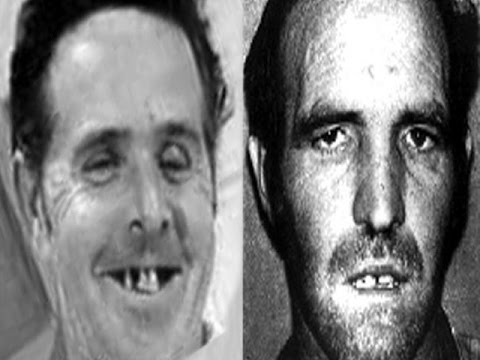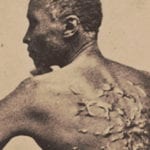10 Laverne Pavlinac
Breaking up with someone can be tough, but there aren’t too many people that feel the need to falsely confess to a murder to get out of a relationship. In 1990, 23-year-old Taunja Bennett was beaten, raped, and strangled to death not far from Portland, Oregon, and Laverne Pavlinac started down the bizarre road of false confessions. When her tips to the police didn’t get her any attention, she eventually contacted them directly. Her original story was that her boyfriend of 10 years, John Sosnovske, had killed the girl, but when she was taken in for questioning, the 52-year-old said that both she and Sosnovske had been involved, and she helped him dispose of the body. When police tried to get her to identify locations and information that hadn’t been released to the public, she actually did fairly well—well enough that they were both arrested. At that point, they were proclaiming innocence but went to trial with evidence that included her taped confessions. At trial, Pavlinac tried to recant her testimony, saying that she’d only confessed in an attempt to get out of her relationship with Sosnovske. In 1991, she was found guilty, based on her original testimony and her luck in pointing out crime scene locations. Sosnovske, tried separately, pleaded no contest in an attempt to at least get out of a death sentence. Both were sentenced to life in prison. A few years later, things got more complicated after Keith Jesperson, also known as the Happy Face Killer, gave a confession and proved better at identifying crime scene locations and information than Pavlinac had been. After Jesperson’s confession, Pavlinac’s daughter said that this wasn’t the first time she’d tried confessing to crimes and implicating Sosnovske. She’d also tried to get him arrested for a bank robbery, but the FBI didn’t take her confession seriously.
9 Henry Lee Lucas
Henry Lee Lucas was a drifter arrested in Texas in 1983. Before long, he had confessed to as many as 600 murders, a far cry from the illegal-weapons charge that had originally gotten him arrested. The question of just how many killings Lucas can actually be connected to is rather hazy. Physical evidence has concretely linked him to two murders. In 1998, then-Governor George W. Bush reversed a death sentence for 10 murders, including the notorious “Orange Socks” case. While in prison, Lucas became the willing scapegoat for a huge number of other cases, and it’s not even known just how many he confessed to. Estimates range from 360–600, but those confessions became rather doubtful when he was caught in clear lies involving several of them. That didn’t stop law enforcement from collecting confessions and closing cases, though, and that’s the major problem with Lucas’s false confessions. Life in the limelight suited him, and in return for confessions, Lucas gained not only notoriety but perks like better food, more comfortable beds, and prison privileges. He later confessed to looking for officers that wanted to close cases, admitting that he was good at getting details out of them and then relaying them back in believable confessions. Sadly, many of the cases that he confessed to were never reopened after his lies came to light. Later, in prison, he went on record as saying that he was a fan of following murder investigations on television, and if killer Rafael Resendez-Ramirez hadn’t been positively linked to eight new murders, he would have confessed to them, too.
8 John Mark Karr
In 2006, John Mark Karr confessed to the murder of child beauty queen JonBenet Ramsey, and his confession brought to light a bizarre world. Among the strangeness were his two marriages to teenage girls—one who was only 13—and his previous jobs as a nanny to three small girls in Germany. Although one of his ex-wives testified to his obsession with the case, she also testified that he had been living with her in Alabama at the time of the murder and that he hadn’t been involved. In 1996, the same year as the murder, Karr made a career change from real estate to teaching, working in schools across the country, but even that was of questionable authenticity. He did work for a while as a substitute teacher, which came to an immediate halt with his arrest for possession of child pornography. After his ex-wife filed a restraining order against him, he went overseas to find work teaching, which was where he was when his confession came. It wasn’t long before investigators began to pick apart his clearly false confession, including his insistence that he had picked her up from school on the day she was killed. Strangely, that’s not the last we heard of Karr. In 2010, he surfaced again, this time amid allegations that he was recruiting girls between four and eight years old to join his cult, supposedly called The Immaculates. The accusations came from ex-fiance Samantha Spiegel, but they’ve proven hard to confirm. Karr had dropped out of sight and was reported to be living as a woman named Alexis Valoran Reich with a group of associates who help him stay out of the public eye.
7 Jerry Pacek
Only 13 years old when he gave the confession that would change his life forever, Jerry Pacek took the blame for the 1958 murder and rape of 52-year-old Lillian Stevick. Pacek had been walking home from his girlfriend’s house around midnight when he saw someone running away from another person who was still alive and moaning. Stevick died 45 minutes after being taken to the hospital, and Pacek was taken in for questioning. At first, they told him it was only because he had been the one to find the victim. But 17 hours later, he confessed to killing her. Originally, the murder weapon hadn’t been found, and he first claimed to have killed her with a “metal object.” When police found a rusty hatchet a football field’s length away from her body, Pacek changed his story to suit their evidence. Charged as an adult, he was convicted in 1959 after acting out the murder in the courtroom. He was released after serving 10 years—and after his attorney had dropped his appeal without telling him. Later investigations into the case uncovered evidence (or lack thereof) that should have been presented at the trial. His clothes were clean, and he had no scratch marks or defensive wounds even though the victim had clearly fought her attacker. Pacek said that he had only confessed to protect his girlfriend. She was 20 at the time, and his parents had already issued a restraining order against her. He had been convinced that if he confessed, he would keep her out of trouble and be clearly proven innocent at trial. Even though he sat with a sketch artist to produce drawings of the man he’d seen, no one else was ever arrested, and his civil suit for wrongful conviction wasn’t successful.
6 Sture Bergwall
Thomas Quick was one of the most notorious, prolific serial killers to come from Sweden. In the 1990s, he confessed to murder after murder, giving police—and the press—all the grisly details that they could possibly want. He claimed that he had killed and eaten a nine-year-old girl, that he had murdered a Dutch couple while they were on a camping trip, and that he had killed 11-year-old Johan Asplund, who disappeared on his way to school in 1980. According to Quick, he strangled and then dismembered the boy, burying the remains in a remote location where they wouldn’t be found—after eating his fingers. There were no remains in the spot that Quick directed them to for a good reason: He was lying. The stories he told were so complete that there were more than 50,000 pages of court documents by the time Quick changed his name back to his birth name—Sture Bergwall. It was only after he stopped cooperating, and psychologists started looking through the files, that they realized that while there was a lot of talk, there wasn’t actually any physical evidence to support any of his claims. By then, he was already confined to the Sater Psychiatric Hospital for the Criminally Insane. In 2008, he confessed that he’d made it all up. With the publishing of a book that exposed the gaps in the case and lack of physical evidence, it all went back to the courts. When asked why he would confess to so many murders if he was innocent, he simply responded that he had been lonely, and he had noticed that the more horrible things a person did, the more attention they got and the more interesting everyone thought that they were. Once he started confessing, it didn’t matter whether he got details right or wrong, even citing one of his victims as a blonde girl from a rural village when she was actually a dark-haired city girl. What he did get right was public knowledge, and his convictions came on flimsy evidence, including a piece of “bone” that turned out to be wood. He was ultimately acquitted of his final murder charge in 2013, leaving a lot of cold cases and unanswered questions for families.
5 Paul Ingram
Paul Ingram was a married father of five, a devout member of the local Pentecostal church, and a Washington state deputy sheriff. In 1988, his daughters accused him of raping them, of participating in satanic rituals, and of sacrificing 25 babies during the rituals. One of his daughters, Ericka, even claimed to have been pregnant and that he had removed the nearly full-term baby from her in order to sacrifice it. Ingram was arrested, and over the course of five months, he went from denying the charges to admitting that it was all true. Even though he claimed not to be able to remember much about any of the incidents, he confessed after a series of interrogations, where he was hypnotized, and after his pastor encouraged him to confess, suggesting that there was no way the girls could make up such terrible things. He began recounting incidents that they had told him happened, saying that they wouldn’t lie about such things, and that he really had indeed forced his daughter to abort his child and performed all kinds of evil rituals. A consulting psychologist grew suspicious of the whole thing, suggesting another scenario to Ingram that his daughters had not, in any way, suggested had happened. When he confessed to this imaginary scenario a few days later, it quickly became clear that he had little control over what he was saying. Ingram later tried to recant his confessions, but the courts refused, and he accepted his 20-year sentence as divine judgment.
4 Jerry Frank Townsend And Frank Lee Smith
Frank Lee Smith and Jerry Frank Townsend both made false confessions when accused with murder, and the real murderer in both cases was Eddie Lee Mosley. Townsend was arrested in 1979, charged with rape. Diagnosed with the mental capabilities of an eight-year-old child, Townsend nevertheless proceeded to confess to a series of murders that had been happening across Florida. Police took him to the scenes and recorded his confessions, which are now thought to have been given in an attempt to please the authority figures that he regarded the police as. After his confessions, he was convicted and served 22 years in jail for the seven murders but was cleared of all of them in 2001. His exoneration began when the mother of one of his supposed victims requested that police take another look at the crime in 1998. By 2000, DNA evidence had linked the murders to Mosley instead of Townsend. Frank Lee Smith, on the other hand, would never see his exoneration, dying of cancer in prison in 2000. He had been arrested and convicted of the murder of Shandra Whitehead on ridiculously flimsy evidence that amounted to little more than the testimony of one eyewitness who identified him as the person that she had seen in the area around the time that the murder took place. Smith’s confession wasn’t even a typical one, and it didn’t come from him as much as it came from the officers who had taken his statement. There were no records of the actual confession, but according to officers, Smith uttered an incriminating statement under questioning. Four years later, the witness recanted her identification and instead identified a picture of Mosley, an accusation that didn’t come in time for Smith to be freed.
3 Stephen Downing
The case and conviction of 17-year-old Stephen Downing was a gross miscarriage of justice that spanned three decades. In 1973, police obtained a signed confession from Downing for the murder of Wendy Sewell. A local girl with a less-than-stellar reputation, Sewell was badly beaten in the graveyard of a local church, where she would often spend her lunch breaks meeting whichever local boy had most recently struck her fancy. It was Downing who found her, running to the graveyard’s gatehouse for help. Paramedics arrived in time to get her to the hospital, where she died from her injuries a few days later. Downing was taken into custody, where he wasn’t informed of his rights or offered a lawyer. Later, he would be assessed as a 17-year-old with learning disabilities and the reading ability of an 11-year-old. After nine hours of questioning, he signed the confession that police had written for him—in words that he didn’t understand. When Downing tried to retract his statement—which he had signed before Sewell died—it was refused, even though there were few people in town that thought he was even remotely capable of killing. He would eventually serve 27 years in jail for the crime that he didn’t commit, and it’s likely he would still be in jail if local newspaper editor Don Hale hadn’t gotten a request to reexamine the case. The more digging he did, the more wrong he found. He even uncovered a woman who had seen a van parked nearby the graveyard and a couple of men acting suspiciously. She’d written down the license number, but police had turned her away. Hale didn’t. Downing was released in 2003 and welcomed back into the town that had always suspected that he was innocent.
2 Ed Brown, Henry Shields And Arthur Ellington
Racial profiling and mob violence descended on the city of Giles, Mississippi, after the March 30, 1934, murder of Raymond Stuart. After suspicion settled on Brown, Shields, and Ellington, police officers attempted to get a confession from Ellington with the help of an angry mob. Subjected to brutal torture and an attempted hanging, Ellington still refused to confess to the murder that he didn’t commit. The next day, Ellington was was again subjected to torture at the hands of law enforcement—including a whipping from the deputy sheriff—when he confessed to the killing. The day after that, the same deputy sheriff was joined by a handful of civilians in the beating and interrogation of Brown and Shields, which led to their forced confessions. Those confessions were given on April 1. All three were charged officially on April 4, the trial was on April 5, and the guilty verdict and death sentence were handed out on April 6. It wasn’t until January 10, 1936, that the case made went before the Supreme Court, and when it did, it changed law enforcement in the United States forever. The treatment and torture of the so-called Kemper Country Trio led to the decision that all people—no matter what race—are afforded the same rights and protections when it comes to due process of law. The verdict of Brown v. Mississippi was a monumental one, especially in the context of the time and place. Kemper County had nearly twice as many lynchings as any other county in Mississippi. The trial extended due process to everyone and also outlawed forced confessions. It was the first court case in the country that had ever dealt with the issue.
1 Robert Hubert
The landscape of London was changed forever by the Great Fire of 1666. As terrified London residents picked up the pieces, they demanded to know what happened, and they demanded someone to blame. At the end of it all, only six people officially died in the fire, but the unofficial number ranges anywhere from several hundred to several thousand people. The fire destroyed 70,000 out of London’s 80,000 homes. At the time, England was at war with France and the Netherlands, making it seem most likely that the fire had been nothing less than an act of terrorism. The British Navy had recently torched the Dutch city of West Terschelling, and the fire in London seemed an impossible coincidence. King Charles declared it was an act of God, and the Duke of York had to venture out into the city to stop the hangings that were starting everywhere. In order to keep the peace, a scapegoat was needed, and they found one when Robert Hubert confessed to starting the fire with the help of 23 other conspirators. A French Protestant watchmaker, Hubert was arrested not long after the fire when he was caught trying to get out of the city. He confessed that the plans for the fire had started in 1665. He and two others had carried it out by lighting a ball of gunpowder and brimstone and throwing it through the window of the bakery. The fact that there was no window where he claimed and that his accomplices were never found made no difference. His story changed a few more times before he was put on trial at the Old Bailey. Even though the lord justice said that he didn’t believe the confession, Hubert was accepted as a scapegoat and hanged. His body was given to the mob, which tore it to pieces. It was only afterward that a ship captain testified that Hubert had been at sea with him when the fire started. Three months later, Parliament officially declared the whole thing an accident. Read More: Twitter
























